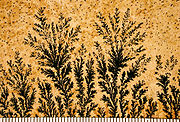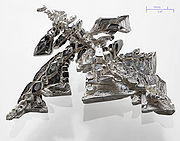.gif)
Dendrite (crystal)
Encyclopedia

Snowflake
Snowflakes are conglomerations of frozen ice crystals which fall through the Earth's atmosphere. They begin as snow crystals which develop when microscopic supercooled cloud droplets freeze. Snowflakes come in a variety of sizes and shapes. Complex shapes emerge as the flake moves through...
formation and frost
Frost
Frost is the solid deposition of water vapor from saturated air. It is formed when solid surfaces are cooled to below the dew point of the adjacent air as well as below the freezing point of water. Frost crystals' size differ depending on time and water vapour available. Frost is also usually...
patterns on a window. Dendritic crystallization forms a natural fractal
Fractal
A fractal has been defined as "a rough or fragmented geometric shape that can be split into parts, each of which is a reduced-size copy of the whole," a property called self-similarity...
pattern. Dendritic crystals can form from growth instabilities that occur when the growth rate is limited by the rate of diffusion of solute atoms to the interface. In this case, there must be a concentration gradient from the supersaturated value in the solution to the concentration in equilibrium with the crystal at the surface. Any protuberance that develops is accompanied by a steeper concentration gradients at its tip. This increases the diffusion rate to the tip. In opposition to this is the action of the surface tension tending to flatten the protuberance and setting up a flux of solute atoms from the protuberance out to the sides. However, overall, the protuberance becomes amplified. This process occurs again and again until a dendrite is produced.
The term "dendrite" comes from the Greek
Greek language
Greek is an independent branch of the Indo-European family of languages. Native to the southern Balkans, it has the longest documented history of any Indo-European language, spanning 34 centuries of written records. Its writing system has been the Greek alphabet for the majority of its history;...
word dendron, which means "tree".
Mineralogy and paleontology
In paleontologyPaleontology
Paleontology "old, ancient", ὄν, ὀντ- "being, creature", and λόγος "speech, thought") is the study of prehistoric life. It includes the study of fossils to determine organisms' evolution and interactions with each other and their environments...
, dendritic mineral crystal forms are often mistaken for fossil
Fossil
Fossils are the preserved remains or traces of animals , plants, and other organisms from the remote past...
s. These pseudofossil
Pseudofossil
Pseudofossils are inorganic objects, markings, or impressions that might be mistaken for fossils. Pseudofossils may be misleading, as some types of mineral deposits can mimic lifeforms by forming what appear to be highly detailed or organized structures. One common example is when manganese oxides...
s form as naturally occurring fissures in the rock are filled by percolating mineral solutions. They form when water rich in manganese
Manganese
Manganese is a chemical element, designated by the symbol Mn. It has the atomic number 25. It is found as a free element in nature , and in many minerals...
and iron
Iron
Iron is a chemical element with the symbol Fe and atomic number 26. It is a metal in the first transition series. It is the most common element forming the planet Earth as a whole, forming much of Earth's outer and inner core. It is the fourth most common element in the Earth's crust...
flows along fractures and bedding planes between layers of limestone
Limestone
Limestone is a sedimentary rock composed largely of the minerals calcite and aragonite, which are different crystal forms of calcium carbonate . Many limestones are composed from skeletal fragments of marine organisms such as coral or foraminifera....
and other rock types, depositing dendritic crystals as the solution flows through. A variety of manganese oxides and hydroxides are involved, including:
- birnessiteBirnessiteBirnessite 2O4 · 1.5 H2O is an oxide mineral of manganese along with calcium, potassium and sodium. It has a dark brown to black color with a submetallic luster. It is also very soft, with a Mohs hardness of 1.5...
(Na4Mn14O27·9H2O) - coronadite (PbMn8O16)
- cryptomelane (KMn8O16)
- hollandite (BaMn8O16)
- romanechiteRomanèchiteRomanèchite is the primary constituent of psilomelane, which is a mixture of minerals. Most psilomelane is not pure romanechite, so it is incorrect to consider them synonyms. Romanèchite is a valuable ore of manganese, which is used in steelmaking. It has a monoclinic crystal structure, a hardness...
((Ba,H2O)Mn5O10) - todorokiteTodorokiteTodorokite is a rare complex hydrous manganese oxide mineral with formula 2Mn3O12·3H2O. It is a brown to black monoclinic mineral which occurs in massive or tuberose forms. It is quite soft with a Mohs hardness of 1.5, and has a specific gravity of 3.49 - 3.82.It was discovered in 1934 in...
((Ba,Mn,Mg,Ca,K,Na)2Mn3O12·3H2O) and others.
A three-dimensional form of dendrite develops in fissures in quartz
Quartz
Quartz is the second-most-abundant mineral in the Earth's continental crust, after feldspar. It is made up of a continuous framework of SiO4 silicon–oxygen tetrahedra, with each oxygen being shared between two tetrahedra, giving an overall formula SiO2. There are many different varieties of quartz,...
, forming moss agate
Agate
Agate is a microcrystalline variety of silica, chiefly chalcedony, characterised by its fineness of grain and brightness of color. Although agates may be found in various kinds of rock, they are classically associated with volcanic rocks and can be common in certain metamorphic rocks.-Etymology...
.
Crystallography and metallurgy

Chemistry
Chemistry is the science of matter, especially its chemical reactions, but also its composition, structure and properties. Chemistry is concerned with atoms and their interactions with other atoms, and particularly with the properties of chemical bonds....
, a dendrite is a crystal
Crystal
A crystal or crystalline solid is a solid material whose constituent atoms, molecules, or ions are arranged in an orderly repeating pattern extending in all three spatial dimensions. The scientific study of crystals and crystal formation is known as crystallography...
that branches into two parts during growth.
NASA microgravity experiment

Materials science
Materials science is an interdisciplinary field applying the properties of matter to various areas of science and engineering. This scientific field investigates the relationship between the structure of materials at atomic or molecular scales and their macroscopic properties. It incorporates...
solidification experiment that researchers use on Space Shuttle
Space Shuttle
The Space Shuttle was a manned orbital rocket and spacecraft system operated by NASA on 135 missions from 1981 to 2011. The system combined rocket launch, orbital spacecraft, and re-entry spaceplane with modular add-ons...
missions to investigate dendritic growth. Dendritic solidification is one of the most common forms of solidifying metals and alloys. When materials crystallize or solidify under certain conditions, they freeze unstably, resulting in dendritic forms. Scientists are particularly interested in dendrite size, shape, and how the branches of the dendrites interact with each other. These characteristics largely determine the properties of the material.
See also
- Monocrystalline whiskerMonocrystalline whiskerA monocrystalline whisker is a filament of material that is structured as a single, defect-free crystal. Typical whisker materials are graphite, alumina, iron, or silicon. Single-crystal whiskers of these materials are noted for having very high tensile strength...
- Whisker (metallurgy)Whisker (metallurgy)Metal whiskering is a crystalline metallurgical phenomenon involving the spontaneous growth of tiny, filiform hairs from a metallic surface. The effect is primarily seen on elemental metals but also occurs with alloys....
- Brownian treeBrownian treeA Brownian tree, whose name is derived from Robert Brown via Brownian motion, is a form of computer art that was briefly popular in the 1990s, when home computers started to have sufficient power to simulate Brownian motion...
- STS-87STS-87STS-87 was a Space Shuttle mission launched from KSC pad 39-B on 19 November 1997. It was the 88th flight of the Space Shuttle, and the 24th flight of Columbia...
- Space Shuttle mission

